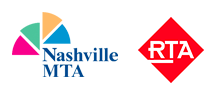Over the past decade, much attention has been placed on the development of Bus Rapid Transit (BRT) systems. These systems provide rail-like service, but with buses, and are typically less expensive to construct than rail service. However, while costs are lower than rail, BRT systems can still be expensive. Implementation times can also be long. In order to provide many of the benefits of BRT service, many transit systems have begun operating “Rapid Bus” services. This type of service includes the elements of BRT that can be implemented on existing roadways at a lower cost and in a much shorter timeframe. Rapid Bus can also be a first step toward full-featured BRT.


I like RapidBus as it is implemented on Gallatin Pike: faster and fewer stops than the 26 Gallatin Pike bus. It needs the ability to turn the lights green for better service.
I am not too keen on the Nolensville Pike implementation: too many stops slows down the commute. I understand why MTA was tempted to cram together stops. The Nolensville RapidBus tries to be both a RapidBus and a local service bus and therefore fails as a RapidBus. RapidBus needs to be six stops per ten miles, not six stops per mile.
In the document linked to my name above I describe a way of using loss-leader, overlapping collectors in high density areas to provide high frequency local service and to deliver transfers to widely separated RapidBus stops. The RapidBus stops can bookend the high density zone. I think this would create a superior transit network because it functions more like a network.
nMotion presents RapidBus — BRT — Light Rail as discrete price/service points for the six major arterials. For the BRT and Light Rail offerings there is at least a realization that collector/crosstown service routes would be brought to BRT/Light Rail stations instead of all routes going downtown. For RapidBus there is a blind spot to this network opportunity.
RapidBus (especially) provides the possibility of joining axial route pairs at the county edge that is not grasped by nMotion. This is more apparent if Dickerson Pike RapidBus could be extended to Goodlettsville and West End/Harding RapidBus could be extended to Bellevue. I understand the temptation to turn West End/Harding at White Bridge but I still think White Bridge could be as well served by overlapping collector/crosstown routes between and beyond the length of White Bridge Road.
In my opinion, nMotion sees a need for high frequency local service (six stops per mile) on White Bridge and mistakenly places a RapidBus there. RapidBus is high frequency but should not be six stops per mile. Four or five stops to Bellevue would be about perfect for that stretch assuming there is collector service within Bellevue.